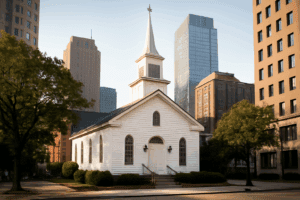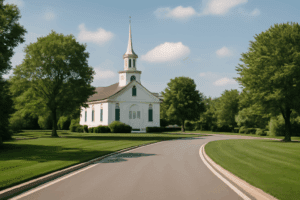Every home has an entryway door designed by the Master Architect to welcome, invite, and allow life to flow through it. Spiritually, evangelism serves as the Church’s entryway, the place where faith steps beyond the comfort of its walls and enters the world. Through these doors, the divine design of God, the Master Architect, revealed through Christ, comes alive. I am reminded of this truth when I reflect on one of my earliest pastoral assignments in Georgia. It felt like walking through a door that God Himself had opened. It was a beautiful rural church nestled in a wooded area off a rocky dirt road. Its A-frame design stood quietly among the pine trees. The building had wooden siding, old-fashioned pews, and polished floors that creaked with every step.
There was something special about that little church. The first day I arrived, members greeted me with Southern hospitality. Their kindness made me feel embraced, valued, and appreciated. They proudly took me on a tour of the church. At first, the sanctuary looked beautiful, but a closer look revealed signs of wear and tear. A large wood stove stood at the front—its warmth had carried the congregation through many cold winters. As we entered the different rooms of the church, I could sense the presence of generations who had come before me still lingering in the rooms. The air was filled with the scent of history and pine. The congregation was small, with only a few faithful members remaining. But I did not mind—I was young, eager, and felt it was an entryway into a deeper understanding of my call to serve.
When we reached the Pastor’s study, they opened the door, and my enthusiasm immediately diminished. Part of the floor had fallen in, leaving a hole large enough for a desk to collapse halfway into it. The office looked as though it had been abandoned for years. There were lots of cobwebs, and a large wasp nest hung above like a warning sign. For a moment, I stood frozen, wondering what I had stepped into. But before I could say a word, one of the elderly women smiled gently and said, “Pastor, don’t you worry—we’ll take care of this. We’ll fix that floor and remove that wasp nest. It’ll be good as new.” Their confidence and faith warmed my heart.
Within two weeks, as promised, the community came together—men and women from the surrounding area, as well as a few members who had not attended in years. They repaired the floor, removed the nest, and shined up the old desk so the room could once again serve as a Pastor’s study. The members were excited to escort me to a renovated office space that I could call home. When I entered that restored office and saw the new wooden floor, I smiled with a deep sense of renewal and relief. I was ecstatic and thankful for their hard work. The office had become a living testament of what happens when faith, service, and the community work together.
That experience reminded me that the Church is not just a building, but a community of people who show up, rebuild, and make space for God’s presence. That is the true architecture of evangelism, action words that form the framework of a church built on love in motion. Our prayers lay the footing, our service frames the walls, and discipleship strengthens the foundation of the Church’s witness. Together, these actions reflect the divine blueprint of Scripture in motion. Each of the following action words becomes a doorway through which the love of Christ enters the heart of the people.
Prayer. Before Jesus chose His disciples, He prayed all night (Luke 6:12–13). Prayer is not preparation for evangelism; it is evangelism. When we pray for others, we bring them before God’s throne of grace.
Serve. Evangelism without service is incomplete. Jesus washed His disciples’ feet before commissioning them (John 13:14–15). Service communicates the Gospel in ways words cannot. Ministries that serve are evangelistic entryways.
Discipleship. Evangelism does not end at conversion; it continues through discipleship, walking with people, teaching them, and holding them accountable in love. Jesus commanded, “Therefore go and make disciples of all nations…” (Matthew 28:19 NIV).
Evangelism is more than a list of action words; it is a living framework. When we move from just speaking faith to living it, evangelism becomes visible, tangible, and transformative. In that moment, believers become living reflections of Christ’s divine design.
Different Communities, Same Mission

Mother Hollingshed’s Country Breakfast
Evangelism looks different depending on where that door opens. Each community — rural, urban, and suburban has its own challenges and opportunities. Yet the mission remains the same: to reach people with the love of Christ right where they are. Being from the South, we are known for our Southern hospitality—a way of life centered on making others feel welcome. Whether you are a neighbor or a guest, you are treated like family. I grew up hearing my mother say, “Can I fix you a plate?” Even to people she had just met. She would go out of her way to cook food as a way of expressing her love for others. Even today, I find myself doing the same.
When preachers and their families move into our region to pastor new assignments, I invite them into our home as a simple way of saying, “Welcome to the family.” Sadly, we live in a world where genuine kindness is often met with suspicion. Many people no longer trust, and understandably so, given the negativity that surrounds us. But even in a cynical world where many people do not play fair, goodness still exists. Some have wondered what I wanted in return when I extended an invitation for dinner. But for me, it is never about receiving something; it is about blessing others. Everyone deserves kindness, love, and grace. Genuine Southern hospitality has no hidden agendas. It is powerful because it is built on relationships, the kind that make people feel seen, valued, and wanted.
When we open our homes and hearts without expecting anything in return, we reflect the heart of Christ. Evangelism, in its purest form, is an invitation to experience God’s grace through connection. That is why I felt right at home when I began my early years of pastoring in rural churches in Georgia. In those communities, everyone knows everyone, and ministry thrives through relationships, trust, and consistency.
Outreach in Rural Churches: Reaching Through Relationship
 That same rural church, with the big hole in the floor of the Pastor’s study, had only five elderly women as members. Yet those faithful five became the pillars that upheld the church. Their faith, humility, and persistence taught me that presence is the true foundation of rural ministry. Life in the rural South moved at a slower pace, and faith was measured by the love we shared with one another. People value authentic relationships above everything else. They are less impressed by our credentials or the eloquence of a sermon, and more moved by sincerity, consistency, and care. There is an old saying: “People don’t care how much you know until they know how much you care.”
That same rural church, with the big hole in the floor of the Pastor’s study, had only five elderly women as members. Yet those faithful five became the pillars that upheld the church. Their faith, humility, and persistence taught me that presence is the true foundation of rural ministry. Life in the rural South moved at a slower pace, and faith was measured by the love we shared with one another. People value authentic relationships above everything else. They are less impressed by our credentials or the eloquence of a sermon, and more moved by sincerity, consistency, and care. There is an old saying: “People don’t care how much you know until they know how much you care.”
Being present means showing up for life’s personal moments, often speaking louder than preaching ever could. In that little church, we made a lasting impact through simple acts of love: delivering meals, hosting dinners in the small fellowship hall or at their homes, and visiting the sick and shut-in together. Every visit, meal, and prayer became a brick in the foundation of trust that evangelism is built upon. Rural outreach calls you to show up, listen more than you speak, and serve the people faithfully.
Outreach in Urban Churches: Reaching Through Compassion
 In urban ministries, compassion forms the framework that keeps hope upright through the cracks of brokenness. In every major city, we admire the beauty of tall buildings that trace the edges of the skyline, but the real beauty lies in how the Church reaches hurting people. The Church should reach the hearts of those burdened by injustice, poverty, and isolation. Believers should function as builders of light to those the world has overlooked. When God called me from a rural church to an urban congregation over twenty-five years ago, I quickly learned that life moves differently there—faster people (people are busier), faster problems (greater pressures), and faster possibilities (greater opportunities). Even in the fast-paced world of urban life, I discovered that hearts still hunger for connection.
In urban ministries, compassion forms the framework that keeps hope upright through the cracks of brokenness. In every major city, we admire the beauty of tall buildings that trace the edges of the skyline, but the real beauty lies in how the Church reaches hurting people. The Church should reach the hearts of those burdened by injustice, poverty, and isolation. Believers should function as builders of light to those the world has overlooked. When God called me from a rural church to an urban congregation over twenty-five years ago, I quickly learned that life moves differently there—faster people (people are busier), faster problems (greater pressures), and faster possibilities (greater opportunities). Even in the fast-paced world of urban life, I discovered that hearts still hunger for connection.
I remember when our church food pantry started collecting just a few canned goods. Over time, it grew into a full outreach ministry center—thanks to the power of partnerships. People did not just come for groceries; they came for prayer, fellowship, and connection. Compassion tore down walls that preaching alone never could. In the heart of the big city, evangelism thrives when the Church becomes a visible expression of love and justice—where hope and need intersect. When believers build with compassion as their framework, they raise structures that can weather any storm and shine as beacons of hope to the city around them. Partner with local shelters, schools, banks, small businesses, grocery stores, and nonprofit organizations to create spaces of hope and help. Urban outreach calls you to serve the oppressed, advocate for the voiceless, and feed both body and soul.
Outreach in Suburban Churches: Reaching Through Innovation
 Historic churches in suburban communities often find themselves surrounded by new developments yet confined by old blueprints of tradition. Jesus taught that “no one pours new wine into old wineskins” (Mark 2:22, NIV). To stay strong, the structure must adapt. This requires reimagining outreach for communities marked by busyness, affluence, and quiet needs. Behind the beautiful scenery, many people quietly struggle with spiritual emptiness, emotional strain, and loneliness, often hidden behind the façade of success. In his article “New Challenges, New Opportunities for Suburban Churches,” Rev. Samuel K. Atchison emphasizes that many suburban congregations now face shifting demographics and social realities that demand a rethinking of traditional models of ministry.
Historic churches in suburban communities often find themselves surrounded by new developments yet confined by old blueprints of tradition. Jesus taught that “no one pours new wine into old wineskins” (Mark 2:22, NIV). To stay strong, the structure must adapt. This requires reimagining outreach for communities marked by busyness, affluence, and quiet needs. Behind the beautiful scenery, many people quietly struggle with spiritual emptiness, emotional strain, and loneliness, often hidden behind the façade of success. In his article “New Challenges, New Opportunities for Suburban Churches,” Rev. Samuel K. Atchison emphasizes that many suburban congregations now face shifting demographics and social realities that demand a rethinking of traditional models of ministry.
Suburban churches must be intentional about meeting people where they are in online spaces, schools, community events, and neighborhood meetings. When congregations take the time to listen to their communities and learn about their cultures, they reflect the heart of Christ, who always designs with people in mind. Sponsor a holiday luncheon for teachers, organize a toy drive, host a worship service in a community center, or engage with local communities online through encouraging posts and prayer focus. Suburban outreach calls you to innovate, adapt, and engage its neighbors with purpose.
From the rocky dirt roads of rural towns to the busy streets of the city and the manicured lawns of the suburbs, evangelism follows the same spiritual blueprint: love in action. This Thanksgiving season, I pray that you will construct ministries of gratitude that move beyond words to become living structures of faith, service, and compassion.
Call to Action
1. Feed the Body and Soul. Host a holiday potluck at your church or home, where everyone comes together. Deliver plates to those who are sick and shut in. Use every plate as a reminder that “man shall not live by bread alone” (Matthew 4:4 NIV).
2. Adopt a Family. Identify families in your church or community through your church members, schools, or social agencies who need help this season. Provide gifts, groceries, or bill assistance with an encouraging note.
3. Visit hospitals, nursing homes, or shelters. Offer caroling, prayer, or handwritten cards. A simple visit can brighten someone’s lonely day.
4. Create Space for Fellowship. Host a fellowship that fosters connection, such as a hot chocolate or root beer float fellowship or a candlelight service. In the suburbs, this might mean community dinners.
5. Shine Online. Use digital platforms to share daily Advent or holiday devotionals, livestream special services, or invite followers to join prayer challenges. Social media and websites are new doorways of evangelism.
References
Atchison, Samuel K. “New Challenges, New Opportunities for Suburban Churches.” Patheos, 5 May 2011, www.patheos.com/resources/additional-resources/2011/05/new-challenges-new-opportunities-for-suburban-churches-samuel-atchison-05-06-2011




